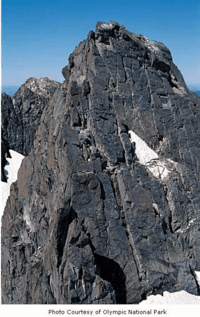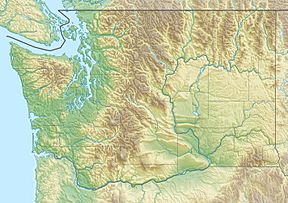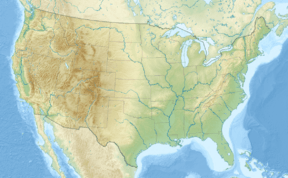Woden - The Valhallas facts for kids
Quick facts for kids Woden - The Valhallas |
|
|---|---|

Woden, from Hugin
|
|
| Highest point | |
| Elevation | 6,038 ft (1,840 m) |
| Prominence | 1,038 ft (316 m) |
| Isolation | 2.96 mi (4.76 km) |
| Parent peak | Mount Tom (7,076 ft) |
| Geography | |
| Location | Olympic National Park Jefferson County, Washington, US |
| Parent range | Olympic Mountains |
| Topo map | USGS Mount Olympus |
| Geology | |
| Age of rock | Eocene |
| Climbing | |
| First ascent | 1966 by Ernie Labistida, Ivan Lundgren |
| Easiest route | class 4 climbing via NE corner |
Woden is a tall mountain, about 6,038-foot (1,840-metre) high. It's found inside Olympic National Park in Jefferson County, Washington state. Its closest taller neighbor is Mount Tom, about 3 mi (4.8 km) away to the north-northwest. Mount Olympus is also nearby, rising 3.8 mi (6.1 km) to the north-northeast.
Woden is the highest peak in a smaller mountain group called The Valhallas. This group is located south of Mount Olympus. Water from the mountain flows into streams that feed the South Fork Hoh River and Queets River. The Geri-Freki Glacier is the only glacier in The Valhallas. It flows down the north side of Woden.
Contents
Mountain History and Naming
The peaks in this area were first called "Pleiades Peaks" by Robert L. Wood. This name came from Greek mythology, where the Pleiades were seven daughters of Atlas. However, this name did not become popular.
Later, in 1970, Glenn Kelsey and Harold Pinsch explored the area. They are given credit for naming the area "The Valhallas." In Norse mythology, "Valhalla" is a grand hall in Asgard, ruled by the god Odin. In Old English, Odin was known as "Woden."
The mountain Woden might have been named "Mount O'Neil" at first. This was done by the 1890 Seattle Press Expedition. They wanted to honor Lt. Joseph O'Neil, who led an earlier trip into the Olympic wilderness in 1885. The first ascent (first successful climb to the top) of Woden was made in 1966. It was climbed by Ernie Labistida and Ivan Lundgren.
Mountain Weather and Climate
The Valhallas are in a marine west coast climate zone. This means they have mild, wet winters and cool, drier summers. This type of climate is common in western North America.
Most weather fronts, which bring changes in weather, start in the Pacific Ocean. They then travel northeast towards the Olympic Mountains. When these weather fronts reach the tall Olympic peaks, they are forced to rise. This causes them to drop their moisture as rain or snow. This process is called Orographic lift. Because of this, the Olympic Mountains get a lot of rain and snow, especially in winter.
During winter, the weather is often cloudy. But in summer, high pressure systems over the Pacific Ocean become stronger. This often leads to clear skies and sunshine. The best time to visit or climb these peaks is usually from July through September.
How the Mountains Were Formed
The Olympic Mountains are made of different types of rock. These rocks were formed from Eocene-era sandstone, turbidite, and basalt from the ocean floor. These materials were pushed up and over other rocks in a process called obduction.
The shape of the mountains we see today was created during the Pleistocene era. This was a time when large sheets of ice, called glaciers, moved across the land. These glaciers carved out valleys and peaks as they advanced and then melted back many times.
Peaks of The Valhallas
The Valhalla Range has several named peaks. Most of them are named after Norse gods. Two exceptions are Sleipner, who is (Odin's horse), and Pelton Peak.
| Name | Elevation (feet) | Prominence (feet) | First ascent | Reference |
|---|---|---|---|---|
| Woden | 6,038 | 1,038 | 1966 | |
| Hugin | 6,000+ | 80 | 1966 | |
| Munin | 6,000+ | 160 | 1971 | |
| Thor | 5,968 | 328 | 1971 | |
| Loki | 5,920+ | 1971 | ||
| Baldur | 5,720+ | 160 | 1971 | |
| Mimir | 5,480+ | 40 | 1978 | |
| Vili | 5,487 | 87 | 1978 | |
| Frigga | 5,406 | 246 | 1971 | |
| Bragi | 5,400+ | 40 | 1978 | |
| Vidar | 5,637 | 677 | 1978 | |
| Mount Sleipner | 5,520 | 520 | 1978 | |
| Pelton Peak | 5,301 | 541 |
Images for kids







